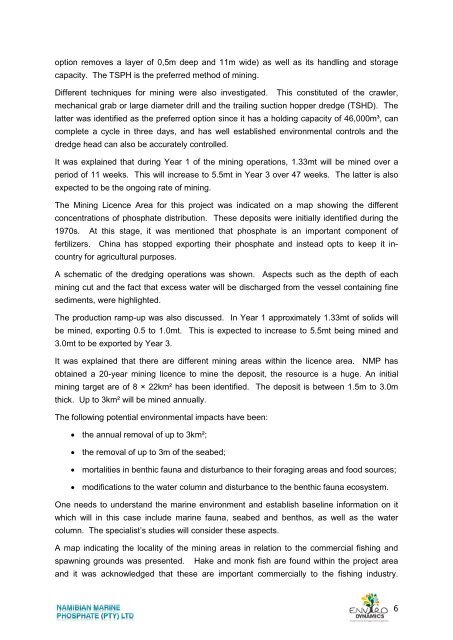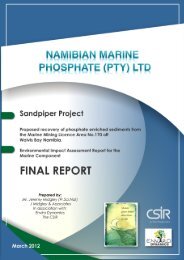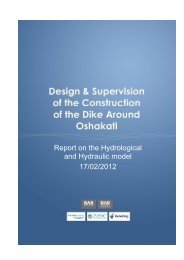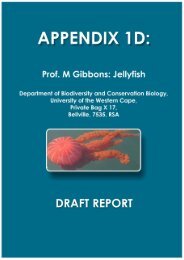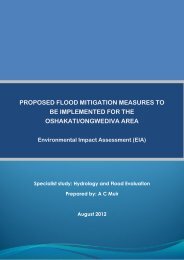2-App-NMP minutes-2-Authorities-WHK - Enviro Dynamics Namibia
2-App-NMP minutes-2-Authorities-WHK - Enviro Dynamics Namibia
2-App-NMP minutes-2-Authorities-WHK - Enviro Dynamics Namibia
You also want an ePaper? Increase the reach of your titles
YUMPU automatically turns print PDFs into web optimized ePapers that Google loves.
option removes a layer of 0,5m deep and 11m wide) as well as its handling and storage<br />
capacity. The TSPH is the preferred method of mining.<br />
Different techniques for mining were also investigated. This constituted of the crawler,<br />
mechanical grab or large diameter drill and the trailing suction hopper dredge (TSHD). The<br />
latter was identified as the preferred option since it has a holding capacity of 46,000m³, can<br />
complete a cycle in three days, and has well established environmental controls and the<br />
dredge head can also be accurately controlled.<br />
It was explained that during Year 1 of the mining operations, 1.33mt will be mined over a<br />
period of 11 weeks. This will increase to 5.5mt in Year 3 over 47 weeks. The latter is also<br />
expected to be the ongoing rate of mining.<br />
The Mining Licence Area for this project was indicated on a map showing the different<br />
concentrations of phosphate distribution. These deposits were initially identified during the<br />
1970s. At this stage, it was mentioned that phosphate is an important component of<br />
fertilizers. China has stopped exporting their phosphate and instead opts to keep it incountry<br />
for agricultural purposes.<br />
A schematic of the dredging operations was shown. Aspects such as the depth of each<br />
mining cut and the fact that excess water will be discharged from the vessel containing fine<br />
sediments, were highlighted.<br />
The production ramp-up was also discussed. In Year 1 approximately 1.33mt of solids will<br />
be mined, exporting 0.5 to 1.0mt. This is expected to increase to 5.5mt being mined and<br />
3.0mt to be exported by Year 3.<br />
It was explained that there are different mining areas within the licence area. <strong>NMP</strong> has<br />
obtained a 20-year mining licence to mine the deposit, the resource is a huge. An initial<br />
mining target are of 8 × 22km² has been identified. The deposit is between 1.5m to 3.0m<br />
thick. Up to 3km² will be mined annually.<br />
The following potential environmental impacts have been:<br />
• the annual removal of up to 3km²;<br />
• the removal of up to 3m of the seabed;<br />
• mortalities in benthic fauna and disturbance to their foraging areas and food sources;<br />
• modifications to the water column and disturbance to the benthic fauna ecosystem.<br />
One needs to understand the marine environment and establish baseline information on it<br />
which will in this case include marine fauna, seabed and benthos, as well as the water<br />
column. The specialist’s studies will consider these aspects.<br />
A map indicating the locality of the mining areas in relation to the commercial fishing and<br />
spawning grounds was presented. Hake and monk fish are found within the project area<br />
and it was acknowledged that these are important commercially to the fishing industry.<br />
6


